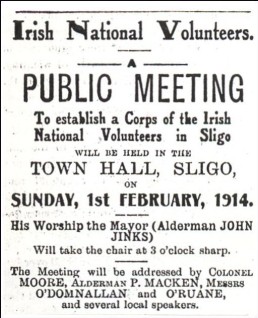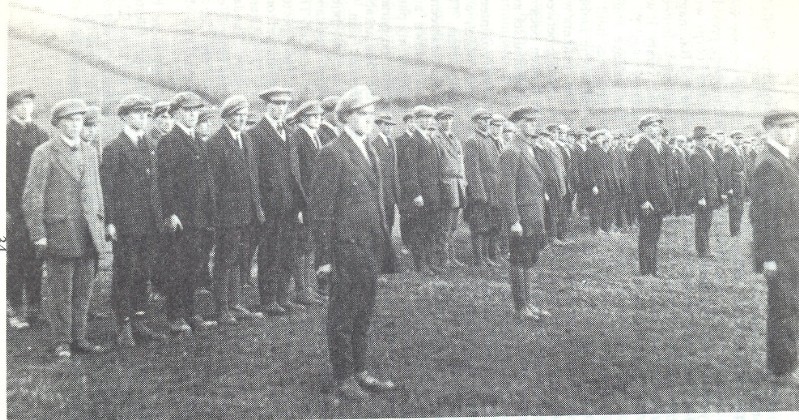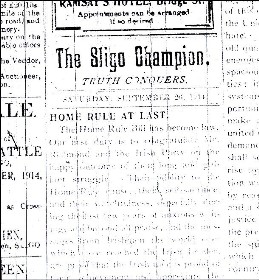Sligo 1914 - Sligo Poets
Main menu:
- Home
-
1912
- 1912
- Sligo Poetry 1912
-
1913
- 1913
- Sligo Poetry 1913
-
1914
- 1914
- Sligo Poetry 1914
-
1915
- 1915
-
Sligo Poetry 1915
- Sligo Newspaper Poems
- Sligo Champion
- Sligo Independent
- Sligo Nationalist
-
1916
- 1916
-
Sligo Poetry 1916
- Sligo Newspaper Poems 1916
- Sligo Champion
- Sligo Nationalist
- Sligo Independent
- The Poets
- Bibliography
- The Author
County Sligo 1914
Mayor of Sligo, Daniel O'Donnell died in early 1914 and rival and fellow-
In the local elections of June 1914 Catherine Brennan was elected for the Glendarragh electoral area in Tubbercurry Rural District, the first woman elected to a public body in Sligo.
A corps of the Irish Volunteers was formed at a public meeting in Sligo on Sunday 1 February 1914 at which Mayor, John Jinks presided. The first public parade of the Volunteers took place on Sunday 15 March when 500 men marched around the town. Sligo Volunteers did not thrive and they developed slowly in the rest of the county, by the end of April only four companies were in existence.
Redmond's insistence that the Irish Party control the Volunteers gave a new impetus to the Volunteers in mid-

Britain’s declaration of war on 4 August 1914 transformed Irish politics. Redmond immediately offered the services of the Irish Volunteers to defend Ireland. Several Irish unionist ex-
On 9 August Major R.W. Hillas of Templeboy offered his services and was appointed Sligo Inspecting Officer. He called on 'every man fit to bear arms to enrol himself in the Irish Volunteer force to protect his home and family from the foreign invader’. There was opposition to his involvement and in early September he resigned.

Irish Volunteers at Keash, County Sligo on Garland Sunday, July 1914.

On 18 September home rule was finally placed on the statute book but suspended for the duration of the war with the question of Ulster unresolved. ‘Home Rule at last!’ the Sligo Champion editorial proclaimed. On the following day when Thomas Scanlan MP arrived in Sligo and addressed a large crowd at the Imperial Hotel he was heckled by a group of protesters from the Trades Council and Transport Union, led by John Lynch.
Redmond's Woodenbridge speech in September split the Volunteers. The majority sided with Redmond and were styled the National Volunteers. The others went with Eoin MacNeill and retained the name Irish Volunteers. The RIC County Inspector said that in Sligo only Keash, Tubbercurry and Grange corps were pro-
The failure of the British government to respond quickly and generously to Redmond's gesture, the postponement of home rule, the prolonged nature of the war, the unpopularity of recruiting and the spectre of conscription led to a sharp decline in support for the IPP and in activity by local UIL branches and Volunteer corps.
In the opening months of the war the local press was full of war-
In November the Sligo Nationalist said that over 700 Sligomen and vicinity were ‘in the firing line or ready to take their places before the German hosts’. Local newspapers reported the enlisting of locals, including Patrick Jinks, eldest son of the mayor, who joined in early November.
Both Sligo MPs supported the war effort in accordance with official Irish Party policy. Local Unionist, Charles O’Hara, chaired a Sligo recruiting committee set up towards the end of 1914 which comprised unionists and nationalists including Mayor Jinks and some AOH and UIL members. In spite of the support of prominent nationalists there was continued dissatisfaction with the numbers enlisting in Sligo especially in the rural areas. At the end of September RIC County Inspector Sullivan complained that ‘Recruiting generally in this County is very slack’.